By: Fredwill Hernandez
The [121st] National Association of Music Merchants [NAMM] Show, which ran from Fri. – June 3 through Sun. – June 5, 2022 — returned [in-person] without any COVID-19 restriction with “mixed emotions.” Many attendees were disappointed with the [show] size and turn out, while others like myself were just glad NAMM returned — even if it was [back] with baby steps, in hopes future [NAMM] shows will eventually regain momentum and return to their glory days.

Absent from the show were companies like Gibson, Fender, PRS, Sennheiser, KHS America’s Hohner [Accordions], and countless others who according to NAMM – “was a 50% drop” from the 7,000 brands that exhibited in 2020, during the last in-person show [right] before the pandemic. A notable difference this year was “the size” of some previous show booths, “their location,” and even though the floor plan allowed [for] more space between booths – a pandemic precaution, it was obvious there was “much less foot traffic.”
On the flip side, companies like Warm Audio, Shure [Mic’s], and Apogee Digital took advantage of the in-person show’s return in being able to personally interact with attendees and its customers.
There was a “buzz” surrounding Warm Audio’s booth due to among others things — its “new and impressive” WA-CX12 tube condenser microphone based on the original AKG C12 which was produced in Austria from 1953 – 1963, and according to Warm Audio has an ability to capture the natural beauty of vocal performances, room sounds, and other miking techniques like [for example] accentuating and smoothing out the upper register of vocal performances, adding just the right amount of pristine high end to a piano performance, or even bringing a natural live sound to professional recordings.

Also unveiled at NAMM was Warm Audio’s WA-47F large-diaphragm condenser, a faithful recreation of a high-SPL in the original ’47-style FET which was released in 1969, and according to Warm Audio gained massive popularity inside recording studios for among other things its ability to handle fast transients with exceptional detail — like capturing huge “boom” kick drum sounds, a punchy guitar, or [even] adding a prestine edge to solo vocals that might need to stand out.
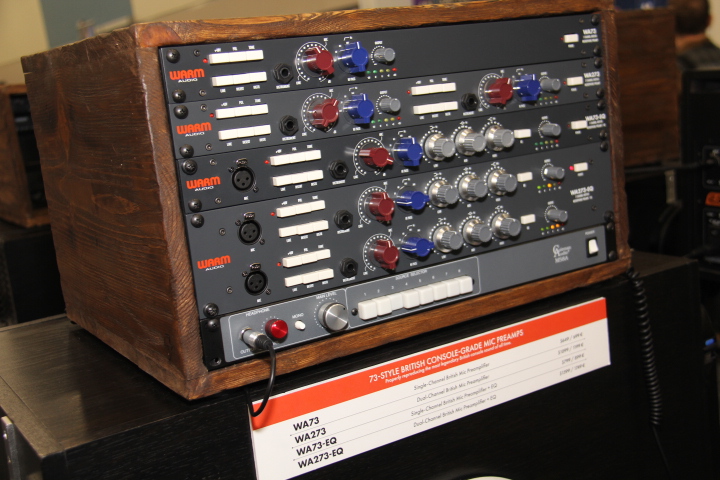
Many among myself — were also impressed with Warm Audio’s WA-8000 modern tube condenser mic, but quite frankly — Warm Audio really “has an arsenal” of [high-end] mic’s, compressors, and equalizers that will definitely “compliment and enhance” any recording studio’s situation or application.

With Dolby Atmos and other 3D [immersive] mixing formats quickly becoming “the newest trend,” Apogee Digital’s booth also had some new, cool, and impressive gear like its Symphony I/O MK II – its plug and play Thunderbolt Monitor Workflow, which according to Apogee Digital –one can effortlessly configure their monitoring system for [either] Dolby Atmos, Sony 360 Reality Audio, and other immersive audio systems — allowing up to 16 Monitor Workflows in all popular multi-channel-configurations from Stereo to Atmos 9.1.6 — with control of up to 32 Speakers outputs “without the need for a separate studio monitor controller,” which in my opinion is “very cool and a game changer.”
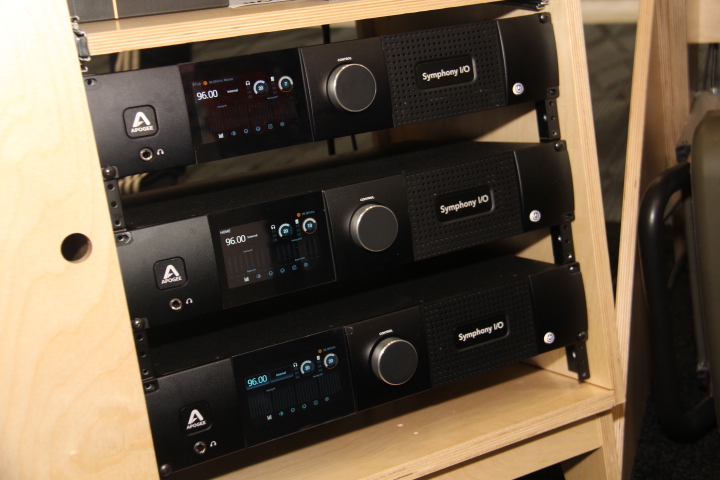
For the producer, musician or recording artist “on the go” Apogee [also] unveiled the third generation Duet 3 interface, considered a step up from the last generation — due to its sleeker [low profile design] aluminum chassis with a scratch-resistant top and a multi-purpose backlit control knob.
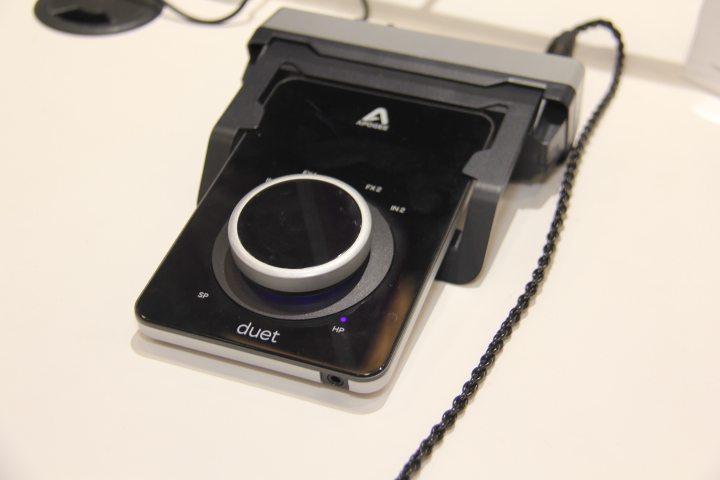
Among other things, the interface is capable of recording up to 24-bit, 192kHz via a USB-C cable and Apogee’s “proprietary cable” using [your choice of] either two instrument inputs, two mic/line inputs and or two balanced outputs. Due to Apogee’s “highly regarded” AD/DA converters and “flawless analogue circuitry” — the Duet 3 [also] has two preamps capable of delivering +65dB of gain through phantom power. The interface is macOS and Windows 10 compatible and can be [also] controlled through Apogee Control 2 app where “one can manage” the interface’s settings allowing “more controls and functions” than through the interface’s [single] volume control knob alone. According to Apogee the Duet 3 also includes on-board hardware DSP [a Digital Signal Processor] that powers the Symphony ECS Channel Strip native plugin which includes EQ, Compression, and Saturation “available separately” for virtually “zero-latency” recording with [Apogee] native FX plugins. For on the go, the interface comes with a stylish padded case, or for a permanent setting, a separate Duet Dock accessory [which can also be used on the go] can be purchased that clips onto the back of the Duet 3 –positioning the interface at the “perfect angle” for easy adjustments and effortless meter visibility and also making its rear-panel cable organization and connectors a piece of cake.
Despite Shure [Mic’s] booth being outside of the [Anaheim, Ca] convention center near the back and practically out of sight, there was no way one could have missed it — due in part to the bright green fluorescent color of their large Shure [Mic’s] booth’s logos, the large [Shure 55SH] inflatable mic’s strategically placed near their booth which attendees “flocked to in order to snap photos and take selfies,” and also the display and buzz surrounding their “new and very impressive” KMS11 wireless [condenser] mic with “an improved capsule.”
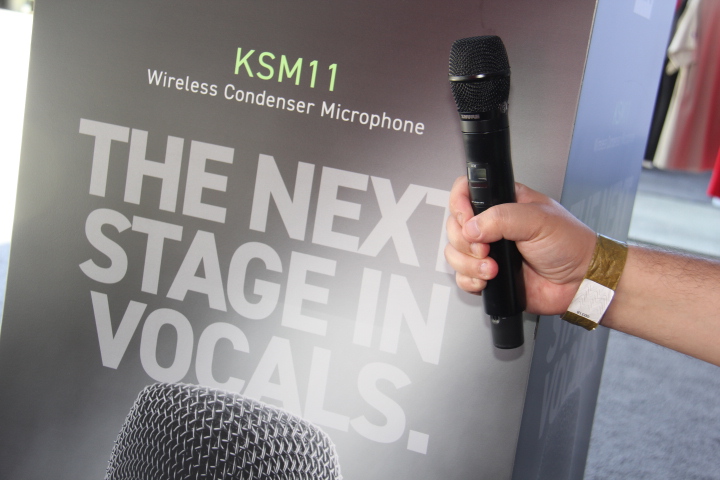
Many up to now would of never have thought of getting rid, selling, or [even] replacing their Shure KSM9 wireless mic’s –but that’s “until now” — with the unveiling of the KSM11 Wireless Condenser Mic — which according to the company — the condenser “mic’s capsule” was specifically developed to take advantage of the increased linearity available via digital signal chains of live stages of today’s digital technology. The KSM11 according to Shure [also] delivers a superior balance of full low-end, rich mid-range and essential high-end details to protect and sustain the “true quality of any artist’s vocals.” Shure states [and ensures] that — professional engineers “now have an ideal [accurate] presentation” of wireless vocal performance to build their mixes around – “EQing by choice and not default,” a “game changer” [in my opinion] and making their [newest] live wireless mic “the go to.”
Another booth that had major foot traffic and engagement was Solid State Logic, among other reasons — due to in part to their newly released Buss +, [in my opinion] a step up of their famous and highly regarded Bus Compressor, “a go to” piece of studio equipment used by top recording engineers and [music] producers for among other things making their music and mixes sound bigger, and more complete with “drive and punch.” According to SSL the Buss + is a new 2U rack unit builds on the original bedrock design [and circuitry] of the Bus Compressor which first appeared on SSL’s 4000B console in 1976. The BUS+ features 2181 that VCA’s [voltage-controlled amplifiers] in its audio path that offer wide-range exponential control of gain and attenuation with low signal distortion and offers the classic time constants and compression ratios which have glued [classic] records together for over four decades.
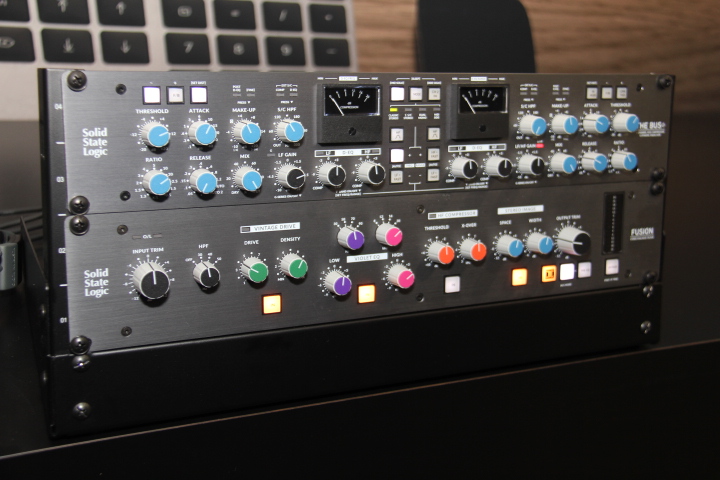
Many attendees were [also] checking out and inquiring about SSL’s “new and very impressive” BIG SIX mixer, “which in my opinion” dubs as a mini desktop SSL mixer with all the bells and whistles and sonic signature of a large format SSL console, and or a plug-in and play USB interface with a fully balanced signal paths from front to back except for its two headphone outputs.
According to SSL, strapped across “the mix bus” is the legendary G Series Bus Compressor, ready to add drive, energy and that all important finished sound to any situation. The BIG SIX uses the same circuit topology as the original design found on the SSL 4000 G-Series console, the BUS Compressor has the identical fixed 4:1 ratio, 30 ms attack and 100 ms release considered the ‘set and forget’ settings for many veteran SSL large format users.

According to SSL the BIG SIX contains a class compliant USB 24 bit –96Khz interface to connect to PC or MAC, paired with 16 [in/out] high caliber A/D and D/A converters that are connected to the SuperAnalogue [which derives from SSL’s XL9000 Consoles] signal chain. The first 12 channels are split across the first 12 inputs/outputs that can be switched pre/post fader. USB channels 13-16 can be routed to or from External inputs and Master buses, and Alternatively, sends 9/10 and 11/12 can also be feed from stereo cue buses making them perfect for ITB [In The Box], meaning you are exclusively mixing inside the DAW. However, just keep in mind I haven’t even begun to scratch the surface concerning the BIG SIX’s capabilities.
NAMM [in my opinion] “needs to be commended” for not only deciding to bring the [in-person] show back, but for its many safety-first [COVID-19] precautionary steps “it took in their major effort to keep everyone safe,” and for [also] allowing anyone registered who couldn’t attend access to the show via their NAMM Show + unified platform, which not only shows “their relentless commitment” to the companies that partake, to the show itself, but equally important the music enthusiasts and general public who attends.






